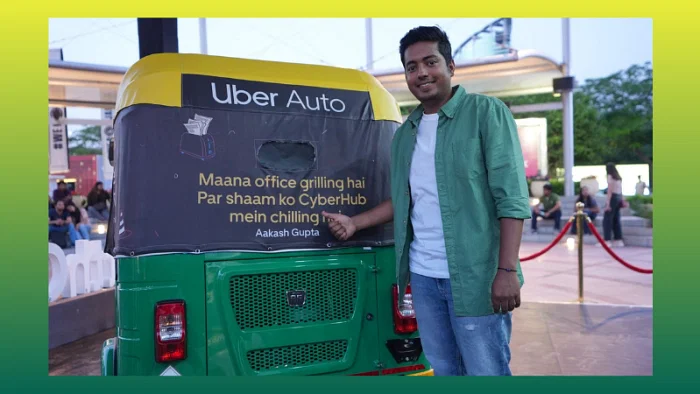Ameya Velankar, Uber India’s head of marketing, recently discussed the company’s increased focus on the auto segment and its recent campaigns. Since Uber’s entry into the Indian market in 2013, it has significantly disrupted the country’s taxi ecosystem, becoming a household name.
However, the brand’s latest campaigns have shifted their focus to the auto-rickshaw segment, also known as three-wheelers. Uber has partnered with popular stand-up comedians Aakash Gupta, Prashasti Singh, and Aashish Solanki for their recent campaigns. These campaigns feature witty one-liners from the comedians displayed on banners placed on autos in Gurugram, aiming to stand out on the roads.
On World Art Day, Uber collaborated with the Aravani Art Project to paint autos at the Carter Road Amphitheater in Mumbai. The autos were painted with inspirational stories from the city, aligning with the event’s theme.
During the Indian Premier League (IPL) season, Uber capitalized on the cricket fever by promoting their three-wheeler mobility product, Uber Auto. The latest campaign showcases the journey of two cricketers, Yashasvi Jaiswal and T. Natarajan, along with India’s first female bouncer, Mehrunissa Shaukat Ali, in an auto. The campaign aims to highlight the convenience and safety features of Uber Auto.
Ameya Velankar emphasizes that app-based rideshare autos have only scratched the surface of their potential. Uber Auto addresses issues such as safety, doorstep pickup, and real-time communication of the live location, offering a solution to these problems.
Uber India’s head of marketing believes that there is still immense potential in the auto-rickshaw segment, considering the significant number of consumers affected by the existing problems. By becoming more relevant to consumers and focusing on Uber Auto over the past 18 months, Uber aims to tap into this untapped market.
While the latest campaign features cricketers Jaiswal and Natarajan, who are in the spotlight due to the ongoing IPL, it was not specifically designed for the tournament. Velankar explains that as a global brand, Uber strives to be relevant at the hyper-local level. The campaign includes stories from different parts of the country, with Jaiswal’s recent century serving as a positive boost for the campaign. Natarajan’s inclusion aims to resonate with the South Indian market, as he hails from Tamil Nadu and plays for the Sunrisers Hyderabad IPL team.
Uber operates in 10,000 cities across 71 countries, and it faces the challenge of staying culturally relevant worldwide. To overcome this, the company works closely with its agency, FCB India, leveraging its local presence and understanding of the Indian market. Regular customer meets and greet events are also held to stay connected with customers.
Uber has a presence in both metros and Tier-II/III towns in India. Their ambition is to expand their geographical footprint while maintaining a uniform product experience. From a marketing perspective, understanding the local nuances is crucial. They aim to scale operations wherever possible or adopt a market-wise approach, such as partnering with stand-up comedians, to cater to specific tiers of the market.





